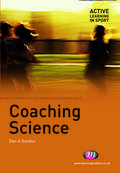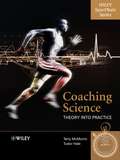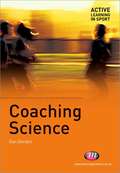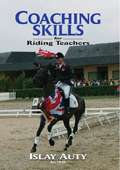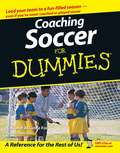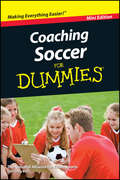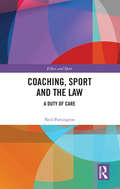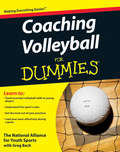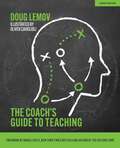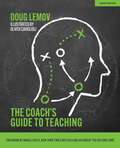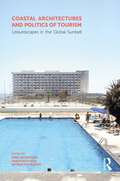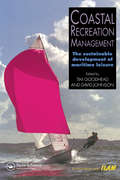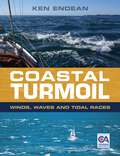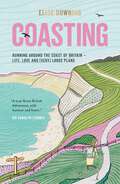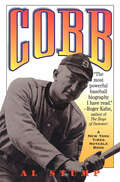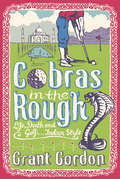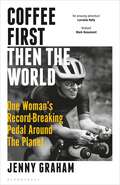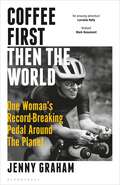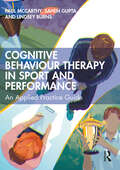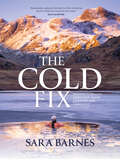- Table View
- List View
Coaching Science
by Dan GordonCoaching is an increasingly important area of sports science courses, and this text provides accessible and up-to-date coverage of this key topic. Modern coaches need to be applied scientists who keep abreast of research and are able to apply a multidisciplinary understanding to their practice. The book therefore examines coaching in terms of biomechanics, physiology and psychology, as well as perennial issues such as athlete motivation, nutrition, design of training programmes, talent identification, monitoring and ethics. Written by an author who combines academic expertise with high-level practical experience, the book successfully links theory with case studies.
Coaching Science: Theory into Practice
by Terry McMorris Tudor HaleCoaching Science and Coaching Studies courses are appearing in increasing numbers in many universities. The textbooks used in most of these courses are either theoretically based sports science texts or practically based coaching books. The former are generally lacking in application while the latter rarely have any scientific input. The reader is, therefore, left to make the links themselves. Coaching Science will bridge that gap covering both theory and practice and, most important, showing how theory informs practice. The book will be multi- and, to some extent, inter-disciplinary, as it is not possible to examine the interaction between coach, performer and task from a single discipline perspective. Each chapter will include overviews of the main theories, but the bulk of the material will be concerned with how such theories can be applied in practice. Good and frequent use of examples will be provided. Throughout, the student will be given problems to solve. At the end of each chapter there will be revision notes, recommended readings and questions on chapter content.
Coaching Science (1st edition)
by Dan GordonCoaching is an increasingly important area of sports science courses, and this text provides accessible and up-to-date coverage of this key topic. Modern coaches need to be applied scientists who keep abreast of research and are able to apply a multidisciplinary understanding to their practice. The book therefore examines coaching in terms of biomechanics, physiology and psychology, as well as perennial issues such as athlete motivation, nutrition, design of training programmes, talent identification, monitoring and ethics. Written by an author who combines academic expertise with high-level practical experience, the book successfully links theory with case studies.
COACHING SKILLS FOR RIDING TEACHERS
by Islay AutyThis book focuses on the skills of coaching rather than how to teach the actual skills of riding. In true Islay Auty style this book is easy to read and hard to put down. It's packed full of useful, easy to find information, making it perfect for anyone who is thinking of, or already training for the UK Coaching Certificate in Equestrian Sport, as well as anyone who is newly qualified or still studying for their teaching certificate. --The British Horse Society The book is written in an interactive style with thought provoking questions embedded into each chapter, such as When you ask a question, do you listen to the answer? At the end of each chapter is a useful summary and top tips. Also various scenarios or case studies are used for further explanation. Coaching Skills is written for riding teachers who wish to enhance their teaching skills, especially for those who are newly qualified or still studying for their teaching certificate. In particular, this book provides excellent reading for those seeking to achieve the UK Coaching Certificate in Equestrian Sport. An interesting and thought- provoking read. --National Equine Student Magazine
Coaching Soccer For Dummies
by National Alliance for Youth SportsPacked with drills and tips for practice and game days The fun and easy way(r) to kick-start your soccer coaching skills Volunteering as a youth soccer coach can be a great experience, both for you and your squad. But what if you've never coached before? Don't worry! This friendly guide explains soccer rules, shows you how to approach coaching, and gives you practical pointers on improving your team's soccer skills and encouraging good sportsmanship. Discover how to Understand soccer rules Develop a coaching philosophy Teach soccer fundamentals Run great practices Lead your team during a game Communicate effectively with parents
Coaching Soccer For Dummies, Mini Edition
by Greg Bach National Alliance for Youth SportsNo synopsis available.
Coaching, Sport and the Law: A Duty of Care (Ethics and Sport)
by Neil PartingtonThe interdependent coach-athlete relationship represents the most fundamental instance of a duty of care in sport. This book defines, analyses and clarifies the duty of care incumbent upon sports coaches and identifies important recommendations of real-world significance for coaching practice. Given the dynamic relationship between coaching, sport and the law, it is imperative that coaches have an informed awareness of the evolving legal context in which they discharge their duty of care. Detailed analysis of a coach’s duty of care has so far been lacking. The book addresses this gap by being the first to critically scrutinise the concept of duty of care in the specific context of sports coaching. Sustained analysis of the developing case law allows the scope and boundaries of the particular duties demanded of coaches to be rigorously examined. The legal principles and court decisions discussed relate to coaching delivered in a wide range of individual and team sports, at both amateur and professional levels of performance, and include common scenarios and challenges frequently encountered by sports coaches globally. By adopting an interdisciplinary approach within a broader sociolegal methodological framework, this book’s detailed analysis and original insights will prove highly instructive for practising coaches, coach educators, and national governing bodies of sport. It also offers extremely valuable insights for students, teachers and practitioners involved in sports law, sports coaching, sports ethics, tort law, sports policy and development, sports studies and physical education.
Coaching, Sport and the Law: A Duty of Care (Ethics and Sport)
by Neil PartingtonThe interdependent coach-athlete relationship represents the most fundamental instance of a duty of care in sport. This book defines, analyses and clarifies the duty of care incumbent upon sports coaches and identifies important recommendations of real-world significance for coaching practice. Given the dynamic relationship between coaching, sport and the law, it is imperative that coaches have an informed awareness of the evolving legal context in which they discharge their duty of care. Detailed analysis of a coach’s duty of care has so far been lacking. The book addresses this gap by being the first to critically scrutinise the concept of duty of care in the specific context of sports coaching. Sustained analysis of the developing case law allows the scope and boundaries of the particular duties demanded of coaches to be rigorously examined. The legal principles and court decisions discussed relate to coaching delivered in a wide range of individual and team sports, at both amateur and professional levels of performance, and include common scenarios and challenges frequently encountered by sports coaches globally. By adopting an interdisciplinary approach within a broader sociolegal methodological framework, this book’s detailed analysis and original insights will prove highly instructive for practising coaches, coach educators, and national governing bodies of sport. It also offers extremely valuable insights for students, teachers and practitioners involved in sports law, sports coaching, sports ethics, tort law, sports policy and development, sports studies and physical education.
Coaching Volleyball For Dummies
by The National Alliance For Youth SportsYour hands-on guide to coaching youth volleyball Have you been asked to coach a youth volleyball team? This friendly, practical guide helps you grasp the basics and take charge on the court. You get expert advice on teaching key skills to different age groups, running safe and effective practices, helping struggling players, encouraging good sportsmanship, and leading your team with confidence during a match. Lay the groundwork for a great season — develop your coaching philosophy, run an effective preseason meeting, and get up to speed on the rules and terminology of the sport Build your team — size up the players, find roles for everyone to succeed in, and coach all different types of kids Teach the basics of volleyball — from serving and passing to setting, attacking, and blocking, instruct your players successfully in all the key elements Raise the level of play — teach more advanced offensive and defensive skills and keep your kids' interest in volleyball going strong Make the moms and dads happy — work with parents to ensure a successful and fun season Score extra points — keep your players healthy and injury free, resolve conflicts, and coach a volleyball club team Open the book and find: Clear explanations of the game's fundamentals An assortment of the sport's best drills The equipment your team needs Player positions and their responsibilities Tips for running fun-filled practices Refinements for your coaching strategies How to meet players' special needs Ten ways to make the season memorable
Coaching Volleyball For Dummies
by The National Alliance For Youth SportsYour hands-on guide to coaching youth volleyball Have you been asked to coach a youth volleyball team? This friendly, practical guide helps you grasp the basics and take charge on the court. You get expert advice on teaching key skills to different age groups, running safe and effective practices, helping struggling players, encouraging good sportsmanship, and leading your team with confidence during a match. Lay the groundwork for a great season — develop your coaching philosophy, run an effective preseason meeting, and get up to speed on the rules and terminology of the sport Build your team — size up the players, find roles for everyone to succeed in, and coach all different types of kids Teach the basics of volleyball — from serving and passing to setting, attacking, and blocking, instruct your players successfully in all the key elements Raise the level of play — teach more advanced offensive and defensive skills and keep your kids' interest in volleyball going strong Make the moms and dads happy — work with parents to ensure a successful and fun season Score extra points — keep your players healthy and injury free, resolve conflicts, and coach a volleyball club team Open the book and find: Clear explanations of the game's fundamentals An assortment of the sport's best drills The equipment your team needs Player positions and their responsibilities Tips for running fun-filled practices Refinements for your coaching strategies How to meet players' special needs Ten ways to make the season memorable
The Coach’s Guide to Teaching
by Doug LemovThe mark of a great coach is a constant desire to learn and grow. A hunger to use whatever can make them better.The best-selling author of Teach Like a Champion and Reading Reconsidered brings his considerable knowledge about the science of classroom teaching to the sports coaching world to create championship caliber coaches on the court and field.What great classroom teachers do is relevant to coaches in profound ways. After all, coaches are at their core teachers.Lemov knows that coaches face many of the same challenges found in the classroom, so the science of learning applies equally to them. Unfortunately, coaches and organizations have a mixed level of understanding of the research and study of the science of learning. Sometimes coaches and organizations build their teaching on myths and platitudes more than science. Sometimes there isn’t any science applied at all.While there are thousands of books and websites a coach can consult to better understand technical and tactical aspects of the game, there is nothing for a coach to consult that explicitly examines the teaching problems on the field, the court, the rink, and the diamond. Until now.Intended to offer lessons and guidance that are applicable to coaches of any sporting endeavor including everyone from parent volunteers to professional coaches and private trainers, Lemov brings the powerful science of learning to the arena of sports coaching to create the next generation of championship caliber coaches.
The Coach’s Guide to Teaching
by Doug LemovThe mark of a great coach is a constant desire to learn and grow. A hunger to use whatever can make them better.The best-selling author of Teach Like a Champion and Reading Reconsidered brings his considerable knowledge about the science of classroom teaching to the sports coaching world to create championship caliber coaches on the court and field.What great classroom teachers do is relevant to coaches in profound ways. After all, coaches are at their core teachers.Lemov knows that coaches face many of the same challenges found in the classroom, so the science of learning applies equally to them. Unfortunately, coaches and organizations have a mixed level of understanding of the research and study of the science of learning. Sometimes coaches and organizations build their teaching on myths and platitudes more than science. Sometimes there isn't any science applied at all.While there are thousands of books and websites a coach can consult to better understand technical and tactical aspects of the game, there is nothing for a coach to consult that explicitly examines the teaching problems on the field, the court, the rink, and the diamond. Until now.Intended to offer lessons and guidance that are applicable to coaches of any sporting endeavor including everyone from parent volunteers to professional coaches and private trainers, Lemov brings the powerful science of learning to the arena of sports coaching to create the next generation of championship caliber coaches.
Coastal Architectures and Politics of Tourism: Leisurescapes in the Global Sunbelt
by Sibel Bozdo 287 An Panayiota Pyla Petros PhokaidesThis volume offers a critical and complicated picture of how leisure tourism connected the world after the World War II, transforming coastal lands, traditional societies, and national economies in new ways.The 21 chapters in this book analyze selected case studies of architectures and landscapes around the world, contextualizing them within economic geographies of national development, the geopolitics of the Cold War, the legacies of colonialism, and the international dynamics of decolonization. Postwar leisure tourism evokes a rich array of architectural spaces and altered coastal landscapes, which is explored in this collection through discussions of tourism developments in the Mediterranean littoral, such as Greece, Turkey, and southern France, as well as compelling analyses of Soviet bloc seaside resorts along the Black Sea and Baltic coasts, and in beachscapes and tourism architectures of western and eastern hemispheres, from Southern California to Sri Lanka, South Korea, and Egypt. This collection makes a compelling argument that "leisurescapes," far from being supra-ideological and apolitical spatial expressions of modernization, development, and progress, have often concealed histories of conflict, violence, social inequalities, and environmental degradation. It will be of interest to architectural and urban historians, architects and planners, as well as urban geographers, economic and environmental historians.
Coastal Architectures and Politics of Tourism: Leisurescapes in the Global Sunbelt
by Sibel BozdoǧanThis volume offers a critical and complicated picture of how leisure tourism connected the world after the World War II, transforming coastal lands, traditional societies, and national economies in new ways.The 21 chapters in this book analyze selected case studies of architectures and landscapes around the world, contextualizing them within economic geographies of national development, the geopolitics of the Cold War, the legacies of colonialism, and the international dynamics of decolonization. Postwar leisure tourism evokes a rich array of architectural spaces and altered coastal landscapes, which is explored in this collection through discussions of tourism developments in the Mediterranean littoral, such as Greece, Turkey, and southern France, as well as compelling analyses of Soviet bloc seaside resorts along the Black Sea and Baltic coasts, and in beachscapes and tourism architectures of western and eastern hemispheres, from Southern California to Sri Lanka, South Korea, and Egypt. This collection makes a compelling argument that "leisurescapes," far from being supra-ideological and apolitical spatial expressions of modernization, development, and progress, have often concealed histories of conflict, violence, social inequalities, and environmental degradation. It will be of interest to architectural and urban historians, architects and planners, as well as urban geographers, economic and environmental historians.
Coastal Recreation Management: The sustainable development of maritime leisure
by Tim Goodhead JohnsonThe maritime environment includes both the water resource of the terrestrial coast and estuarine and coastal inshore waters. This book, for undergraduate students and those training in the field, relates the need to manage water-based leisure activities with the need to manage the maritime environment on which they depend.
Coastal Recreation Management: The sustainable development of maritime leisure
by Tim Goodhead JohnsonThe maritime environment includes both the water resource of the terrestrial coast and estuarine and coastal inshore waters. This book, for undergraduate students and those training in the field, relates the need to manage water-based leisure activities with the need to manage the maritime environment on which they depend.
Coastal Turmoil: Winds, Waves and Tidal Races
by Ken EndeanMost boating is done in coastal waters, yet being close to land canoften present greater dangers than sailing offshore. Near to the coast,sea conditions are more complex: winds and currents change in strengthand direction, often unpredictably, waves are distorted by shallows,and even in fine weather there are tidal races, tricky headlands andother areas of rough water that can increase the risks of human error,gear failure and seasickness.Manyof the recommended techniques used in offshore voyaging - such as lyingto a sea anchor or trailing warps - are not suitable when close toland. In this highly practical guide, filled with helpful tips,real-time techniques and sound advice borne of years of first handexperience, Ken Endean explains the phenomena of rough water and showshow a good understanding of coastal sea conditions and careful passageplanning should enable boaters to avoid the roughest areas, seekshelter underway and thereby reduce passage times.He includesadvice on: coastal winds and waves, shallow water and shoaling, swellsand currents, tides and currents in conflict, estuary effects, bars andbanks, when to take the long way, how to read the surface, getting intoharbour safely, making the most of smooth water, and much more.Coastalboaters have little scope for mistakes and plenty of opportunities toexercise skill and sound seamanship - this practical down-to-earth bookwill enable everyone, whether in a yacht or a powerboat, to do justthat.
Coasting: Running Around the Coast of Britain – Life, Love and (Very) Loose Plans
by Elise DowningElise had a new job, flat and relationship – and they were all making her utterly miserable. Then the obvious solution hit her: run 5,000 miles around the coast of Britain. Over the next 301 days, she saw Britain at its most wild and wonderful, and discovered that running away doesn’t solve your problems – but it's more fun than dealing with them.
Cobb: A Biography
by Al StumpA New York Times Notable Book; Spitball Award for Best Baseball Book of 1994; Basis for a major Hollywood motion picture. Now in paperback, the biography that baseball fans all across the country have been talking about. Al Stump redefined America's perception of one of its most famous sports heroes with this gripping look at a man who walked the line between greatness and psychosis. Based on Stump's interviews with Ty Cobb while ghostwriting the Hall-of-Famer's 1961 autobiography, this award-winning new account of Cobb's life and times reveals both the darkness and the brilliance of the "Georgia Peach." "The most powerful baseball biography I have read."--Roger Kahn, author of THE BOYS OF SUMMER
Cobras in the Rough
by Grant GordonWhen his father dies suddenly, Grant Gordon's life descends into freefall. Having long harboured an obsession with the British in India, and in particular what they did for recreation, Grant goes to find the golf courses the British built during the Raj and decides to play them.Along the way, he has a golf lesson on the highest golf course in the world, in the mountains of Kashmir; negotiates cobras, peacocks and monkeys in Delhi - on a course moulded by the British around the ruins of a Mughal emperor's palace; has a round with Indian Army colonels in the shadow of Everest; gets drenched several times over on the wettest golf course on Earth; and searches on Tiger Hill for Darjeeling's lost British golf course. In Agra he tees off in full view of the Taj Mahal, while in Lucknow, the ghosts of the famous siege during the 1857 Mutiny seem to affect his swing. Throughout, he is faced with the challenge of getting his golf clubs to increasingly obscure locations, using an array of quirky transport.As Grant travels across India, he slowly begins to understand the relationship he had with his father. Cobras in the Rough is a book about golf but also about fathers and sons, and the ways in which they follow, or refuse to follow, in each other's footsteps.
Coffee First, Then the World: One Woman's Record-Breaking Pedal Around the Planet
by Jenny Graham'An amazing adventure... I was left in total awe' - Lorraine Kelly'Brilliant' - Mark Beaumont 'A compelling account of a truly remarkable achievement' - Tim Moore, travel writer16 countries, 124 days and 18,000 miles. This is the story of one woman's solo lap of the planet by bike.'The relief was immense: no longer was I talking, thinking or worrying about this. I was just actually doing it. I, Jenny Graham, was riding around the actual world!'In 2018, amateur cyclist Jenny Graham left family and friends behind in Scotland to become the fastest woman to cycle around the world. Alone and unsupported, she crossed the finish line at the Brandenburg Gate in Berlin four months later, smashing the female record by nearly three weeks. With infectious wit and honesty, Jenny brings readers into her remarkable Round the World adventure, as she takes on four continents, 16 countries – and countless cups of coffee. Her journey swerves from terrifying near road collisions in Russia and weather extremes in Australia to breathtaking landscapes in Mongolia and exhilarating wildlife encounters in North America. Tight on time and money, she resorts to fixing her bike on the fly, sleeping on roadsides and often riding through the night to stay on track and complete her mission.As she battles physical and mental challenges to race against the clock, Jenny gradually opens up to the joy of the adventure and all its daily discoveries. She gives in to her impulse to connect with people, making friends with strangers across the globe and embracing new cultures. Coffee First, Then the World is her account of a record-breaking ride, and how one woman and a humble bike conquered the world.
Coffee First, Then the World: One Woman's Record-Breaking Pedal Around the Planet
by Jenny Graham'An amazing adventure... I was left in total awe' - Lorraine Kelly'Brilliant' - Mark Beaumont 'A compelling account of a truly remarkable achievement' - Tim Moore, travel writer16 countries, 124 days and 18,000 miles. This is the story of one woman's solo lap of the planet by bike.'The relief was immense: no longer was I talking, thinking or worrying about this. I was just actually doing it. I, Jenny Graham, was riding around the actual world!'In 2018, amateur cyclist Jenny Graham left family and friends behind in Scotland to become the fastest woman to cycle around the world. Alone and unsupported, she crossed the finish line at the Brandenburg Gate in Berlin four months later, smashing the female record by nearly three weeks. With infectious wit and honesty, Jenny brings readers into her remarkable Round the World adventure, as she takes on four continents, 16 countries – and countless cups of coffee. Her journey swerves from terrifying near road collisions in Russia and weather extremes in Australia to breathtaking landscapes in Mongolia and exhilarating wildlife encounters in North America. Tight on time and money, she resorts to fixing her bike on the fly, sleeping on roadsides and often riding through the night to stay on track and complete her mission.As she battles physical and mental challenges to race against the clock, Jenny gradually opens up to the joy of the adventure and all its daily discoveries. She gives in to her impulse to connect with people, making friends with strangers across the globe and embracing new cultures. Coffee First, Then the World is her account of a record-breaking ride, and how one woman and a humble bike conquered the world.
Cognitive Behaviour Therapy in Sport and Performance: An Applied Practice Guide
by Paul Mccarthy Sahen Gupta Lindsey BurnsMany sport and performance psychologists worldwide practise cognitive behaviour therapy (CBT) as a therapeutic and applied practice approach. But no textbook currently offers a blueprint to understand and use CBT in sport and performance settings. Cognitive Behaviour Therapy in Sport and Performance: An Applied Practice Guide builds upon a tangible foundation for the practice of CBT and related techniques in sport and performance contexts. This new book presents key points to help students and practitioners bring CBT into the sport and performance context. We focus on the ‘what is’ and the ‘how to’. Drawing upon the latest research and a wealth of applied practice experience, this easy-to-use guide takes the reader through each step of the CBT process with case examples, plain instructions, and worksheets to maximise the quality and depth necessary for effective CBT practice. As an applied guide, this book educates undergraduates and postgraduates in sport and performance psychology (and all its variants). This book is an instrumental guidance material for sport and exercise psychology students but also invaluable as a practice guide for performance psychology trainees in applied practice placements and as a refresher primer for established professionals.
Cognitive Behaviour Therapy in Sport and Performance: An Applied Practice Guide
by Paul Mccarthy Sahen Gupta Lindsey BurnsMany sport and performance psychologists worldwide practise cognitive behaviour therapy (CBT) as a therapeutic and applied practice approach. But no textbook currently offers a blueprint to understand and use CBT in sport and performance settings. Cognitive Behaviour Therapy in Sport and Performance: An Applied Practice Guide builds upon a tangible foundation for the practice of CBT and related techniques in sport and performance contexts. This new book presents key points to help students and practitioners bring CBT into the sport and performance context. We focus on the ‘what is’ and the ‘how to’. Drawing upon the latest research and a wealth of applied practice experience, this easy-to-use guide takes the reader through each step of the CBT process with case examples, plain instructions, and worksheets to maximise the quality and depth necessary for effective CBT practice. As an applied guide, this book educates undergraduates and postgraduates in sport and performance psychology (and all its variants). This book is an instrumental guidance material for sport and exercise psychology students but also invaluable as a practice guide for performance psychology trainees in applied practice placements and as a refresher primer for established professionals.
The Cold Fix: Drawing strength from cold water swimming and immersion
by Sara Barnes‘The cold water has given me the key to unlock myself within a place I didn’t know existed: the community of cold water swimmers right around the world. What binds us all together is the cold and how it makes us feel: brave enough to tackle even the toughest of life’s issues.’Having been a keen runner and cyclist all her life, in 2017 Sara Barnes was diagnosed with severe osteoarthritis and found herself facing major surgery and a future of limited mobility. Rather than obsessing about what she could no longer do, she decided to focus on what she could do and took to the water of the tarns, river pools and lakes in her home county of Cumbria. A new appreciation of being in nature and love of cold water swimming and immersion was born.In The Cold Fix, Sara takes the reader on an enthralling journey, from her first tentative steps into the water, to meeting other swimmers from around the world who share her passion and who can help her answer the question: what is it about cold water that proves irresistible to an increasing number of people?
